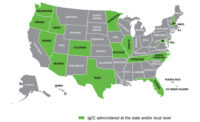In September, the American Concrete Institute plans to publish a guide to help engineers meet the requirements of ACI’s first model code for the repair of existing structural-concrete buildings. And early next year, ACI expects to release for public comment the draft of an updated version of the code, published in 2013.
ACI 562-13 “Code Requirements for Evaluation, Repair and Rehabilitation of Concrete Buildings and Commentary” was written to establish rules for better performance of concrete structures and emphasizes performance-based rather than prescriptive requirements. ACI 562-13 sets the required minimum repair practices and, if followed, helps achieve quality and safe structures, says the code writing group.
Filling a Need
ACI saw the need for the model code because of indications from the field that not all concrete repairs were performing satisfactorily due to design, construction and material selection choices. “The code for new construction does not work for repair work,” especially because many of the old structures, built under earlier codes, would not comply with the newest code, says Jay Paul, senior principal with Klein & Hoffman Inc. and chairman of the ACI committee for the Guide to the Code for Evaluation, Repair and Rehabilitation of Concrete Buildings.
Paul calls ACI 562-13 a “work in progress” that needs interpretation. The guide provides that, he says.
The guide, written by Wiss, Janney, Elstner Associates Inc. and reviewed and approved by ACI and the International Concrete Repair Institute, follows the organization of ACI 562-13 and also includes examples of repair projects.
The document covers the applicability of ACI 562; preliminary evaluations to determine a compliance method for meeting the code requirements; strength reduction factors and load combinations both during and after the repair; and requirements for evaluation, determination of material properties and load testing. It also includes considerations for the design of structural repairs, durability requirements, construction considerations and quality assurance.
The updated code, ACI 562-16, will align terminology “for 100% consistency” with other documents, such as those published by the American Society of Civil Engineers and the International Standards Organization, says Keith Kesner, chairman of the ACI 562-16 committee and a project manager with CVM Engineers.
The goal also is to provide a model code that is better integrated with the International Existing Building Code, first published in 2003 by the International Code Council. The new version will also better define unsafe conditions for existing structures, says Kesner. “It’s a great document for engineers working on existing buildings.”




Post a comment to this article
Report Abusive Comment